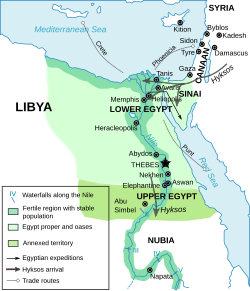
Back Middelryk van Egipte Afrikaans Mittleres Reich (Ägypten) ALS المملكة المصرية الوسطى Arabic المملكه الوسطانيه ARZ Imperiu Mediu d'Exiptu AST Orta padşahlıq (Misir) Azerbaijani Сярэдняе царства (Егіпет) Byelorussian Средно царство Bulgarian মিশরের মধ্য রাজ্য Bengali/Bangla Rouantelezh krenn Henegipt Breton
Middle Kingdom of Egypt | |||||||||
|---|---|---|---|---|---|---|---|---|---|
| c. 2055 BC–c. 1650 BC | |||||||||
 | |||||||||
| Capital | Thebes, Itjtawy | ||||||||
| Common languages | Ancient Egyptian | ||||||||
| Religion | Ancient Egyptian religion | ||||||||
| Government | Divine, absolute monarchy | ||||||||
| Pharaoh | |||||||||
• c. 2061 – 2010 BC | Mentuhotep II (first) | ||||||||
• c. 1650 BC | Merneferre Ay or last king of the Thirteenth Dynasty of Egypt | ||||||||
| History | |||||||||
• Began | c. 2055 BC | ||||||||
• Ended | c. 1650 BC | ||||||||
| |||||||||
| Today part of | Egypt Sudan | ||||||||
| History of Egypt |
|---|
 |
|
|
| Periods and dynasties of ancient Egypt |
|---|
|
All years are BC |
The Middle Kingdom of Egypt (also known as The Period of Reunification) is the period in the history of ancient Egypt following a period of political division known as the First Intermediate Period. The Middle Kingdom lasted from approximately 2040 to 1782 BC, stretching from the reunification of Egypt under the reign of Mentuhotep II in the Eleventh Dynasty to the end of the Twelfth Dynasty. The kings of the Eleventh Dynasty ruled from Thebes and the kings of the Twelfth Dynasty ruled from el-Lisht.
The concept of the Middle Kingdom as one of three golden ages was coined in 1845 by German Egyptologist Baron von Bunsen, and its definition evolved significantly throughout the 19th and 20th centuries.[1] Some scholars also include the Thirteenth Dynasty of Egypt wholly into this period, in which case the Middle Kingdom would end around 1650 BC, while others only include it until Merneferre Ay around 1700 BC, last king of this dynasty to be attested in both Upper and Lower Egypt. During the Middle Kingdom period, Osiris became the most important deity in popular religion.[2] The Middle Kingdom was followed by the Second Intermediate Period of Egypt, another period of division that involved foreign rule of Lower Egypt by the Hyksos of West Asia.
- ^ Schneider, Thomas (27 August 2008). "Periodizing Egyptian History: Manetho, Convention, and Beyond". In Klaus-Peter Adam (ed.). Historiographie in der Antike. Walter de Gruyter. pp. 181–197. ISBN 978-3-11-020672-2.
- ^ David, Rosalie (2002). Religion and Magic in Ancient Egypt. Penguin Books. p. 156